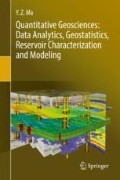Abstract
This chapter first gives an overview of the main characteristics of seismic data and basic analytics using seismic data. It then presents identifications of facies and mapping of continuous reservoir properties using seismic data through mathematical correlation-based methods. The presentation emphasizes analytics in reservoir characterization using seismic attributes. In the last two to three decades, the generation of many seismic attributes from various methods, such as amplitude versus offset (AVO), inversion, and signal analysis, has become common, making seismic attributes part of geoscience big data. There is also an increasing trend in data-analytical methods for treating attribute data. The traditional use of seismic data for structural and stratigraphic interpretations of reservoirs is presented for construction of reservoir-model frameworks in Chap. 15.
We have to remember that what we observe is not nature in itself, but nature exposed to our method of questioning.
Werner Heisenberg
Access this chapter
Tax calculation will be finalised at checkout
Purchases are for personal use only
References
Avseth, P., Mukerji, T., & Mavko, G. (2005). Quantitative seismic interpretation. Cambridge: Cambridge University Press.
Brown, A. R. (1999). Interpretation of three-dimensional seismic data (AAPG Memoir 42) (5th ed.). Tulsa: AAPGL, 514p.
Chen, Q., & Sidney, S. (1997). Seismic attribute technology for reservoir forecasting and monitoring. The Leading Edge, 16, 445–450.
Chopra, S., & Marfurt, K. J. (2007). Seismic attributes for prospect identification and reservoir characterization (SEG Geophysical Developments Series No.11). Tulsa: SEG.
Dvorkin, J., Gutierrez, M., & Grana, D. (2014). Seismic reflections of rock properties. New York: Cambridge University Press.
Iske, A., & Randen, T. (Eds.). (2005). Mathematical methods and modelling in hydrocarbon exploration and production. Dordrecht: Springer.
Ma, Y. Z. (2010). Error types in reservoir characterization and management. Journal of Petroleum Science and Engineering, 72(3–4), 290–301. https://doi.org/10.1016/j.petrol.2010.03.030.
Ma, Y. Z. (2011). Pitfalls in prediction of rock properties using multivariate analysis and regression method. Journal of Applied Geophysics, 75(2), 390–400.
Ma, Y. Z., & Gomez, E. (2015). Uses and abuses in applying neural networks for predictions in hydrocarbon resource evaluation. Journal of Petroleum Science and Engineering, 133, 66–75.
Ma, Y. Z., Gomez, E., & Luneau, B. (2017). Integrations of seismic and well-log data using statistical and neural network methods. The Leading Edge, 36(4), 324–329.
Marple, L. (1982). Frequency resolution of Fourier and maximum entropy spectral estimates. Geophysics, 47(9), 1303–1307.
Papoulis, A. (1965). Probability, random variables and stochastic processes. New York: McGraw-Hill, 583p.
Papoulis, A. (1977). Signal analysis. New York: McGraw-Hill, 431p.
Sheriff, R. E., & Geldart, L. P. (1995). Exploration seismology (2nd ed.). Cambridge: Cambridge University Press.
Simm, R., & Bacon, M. (2014). Seismic amplitude: An interpreter’s handbook. Cambridge/New York: Cambridge University Press.
Wackernagel, H. (2003). Multivariate geostatistics: An introduction with applications (3rd ed.). Berlin: Springer, 387p.
Author information
Authors and Affiliations
Rights and permissions
Copyright information
© 2019 Springer Nature Switzerland AG
About this chapter
Cite this chapter
Ma, Y.Z. (2019). Seismic Data Analytics for Reservoir Characterization. In: Quantitative Geosciences: Data Analytics, Geostatistics, Reservoir Characterization and Modeling. Springer, Cham. https://doi.org/10.1007/978-3-030-17860-4_12
Download citation
DOI: https://doi.org/10.1007/978-3-030-17860-4_12
Published:
Publisher Name: Springer, Cham
Print ISBN: 978-3-030-17859-8
Online ISBN: 978-3-030-17860-4
eBook Packages: EnergyEnergy (R0)

